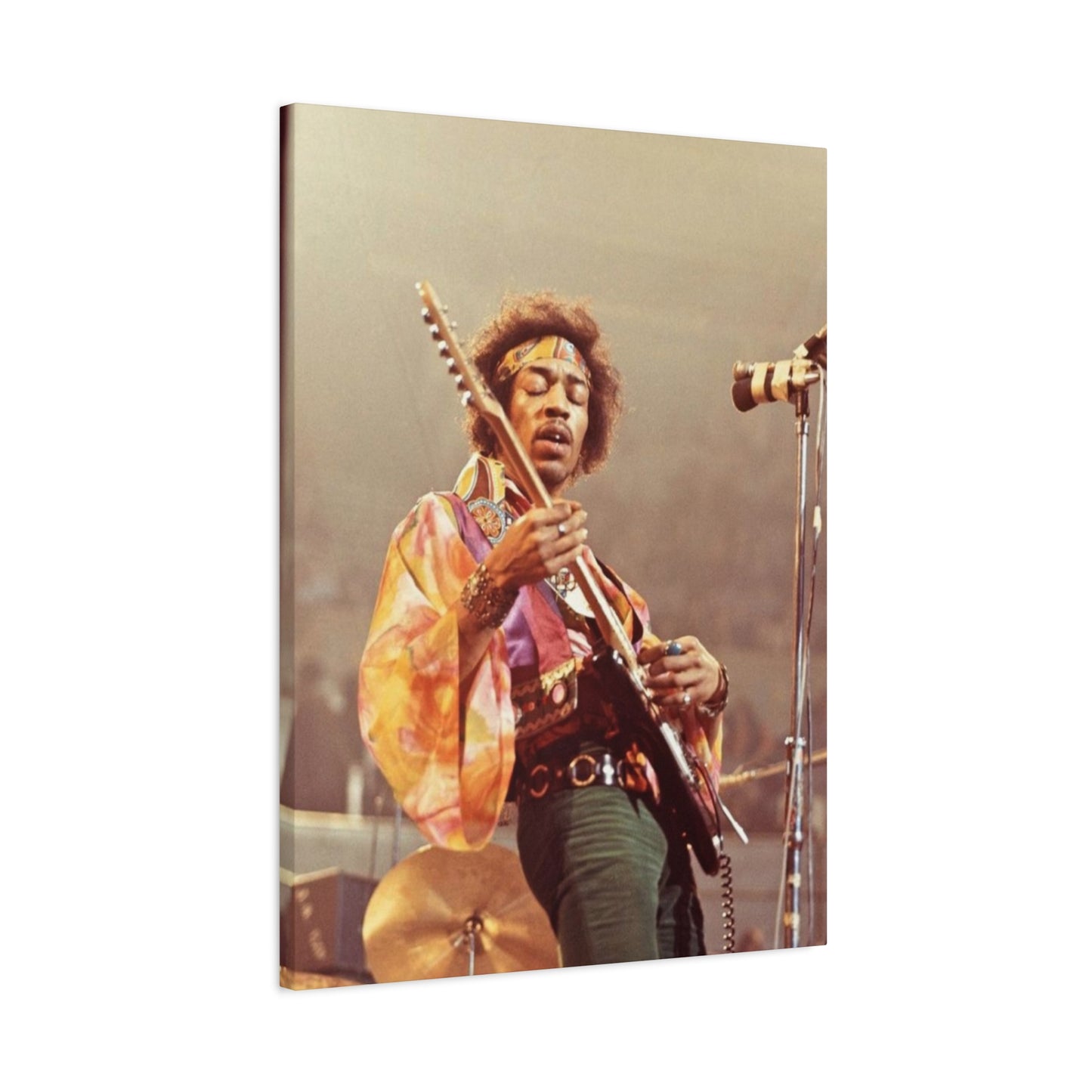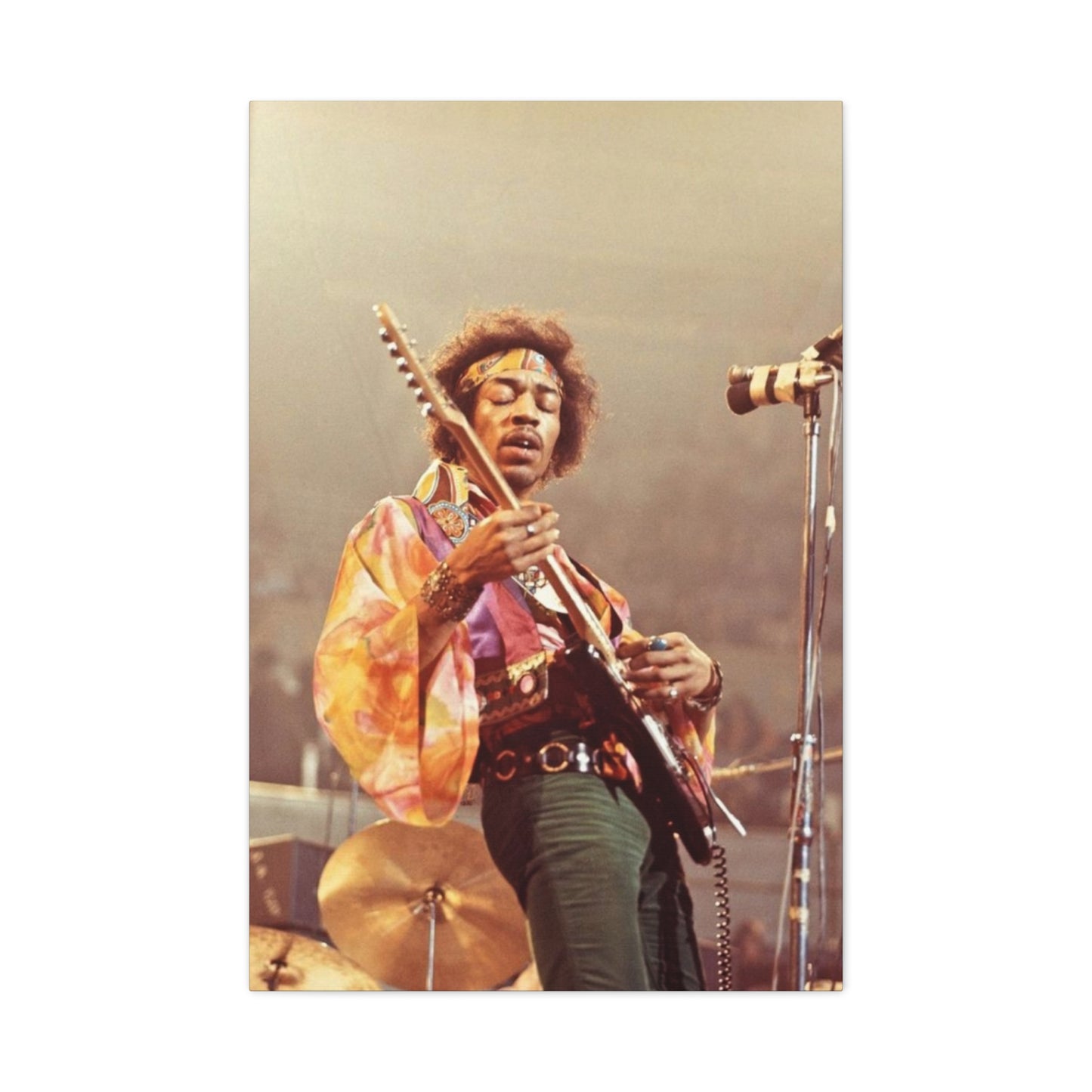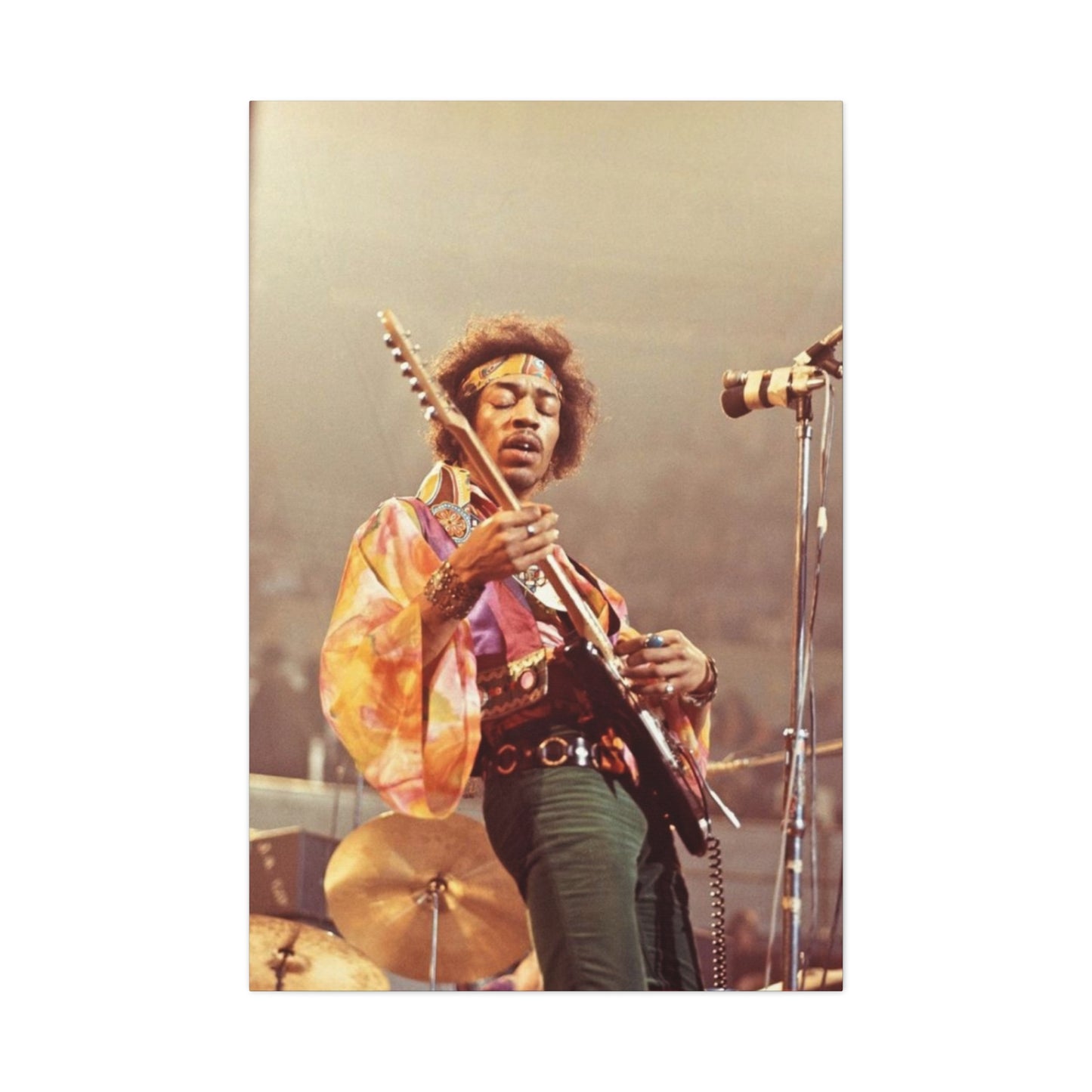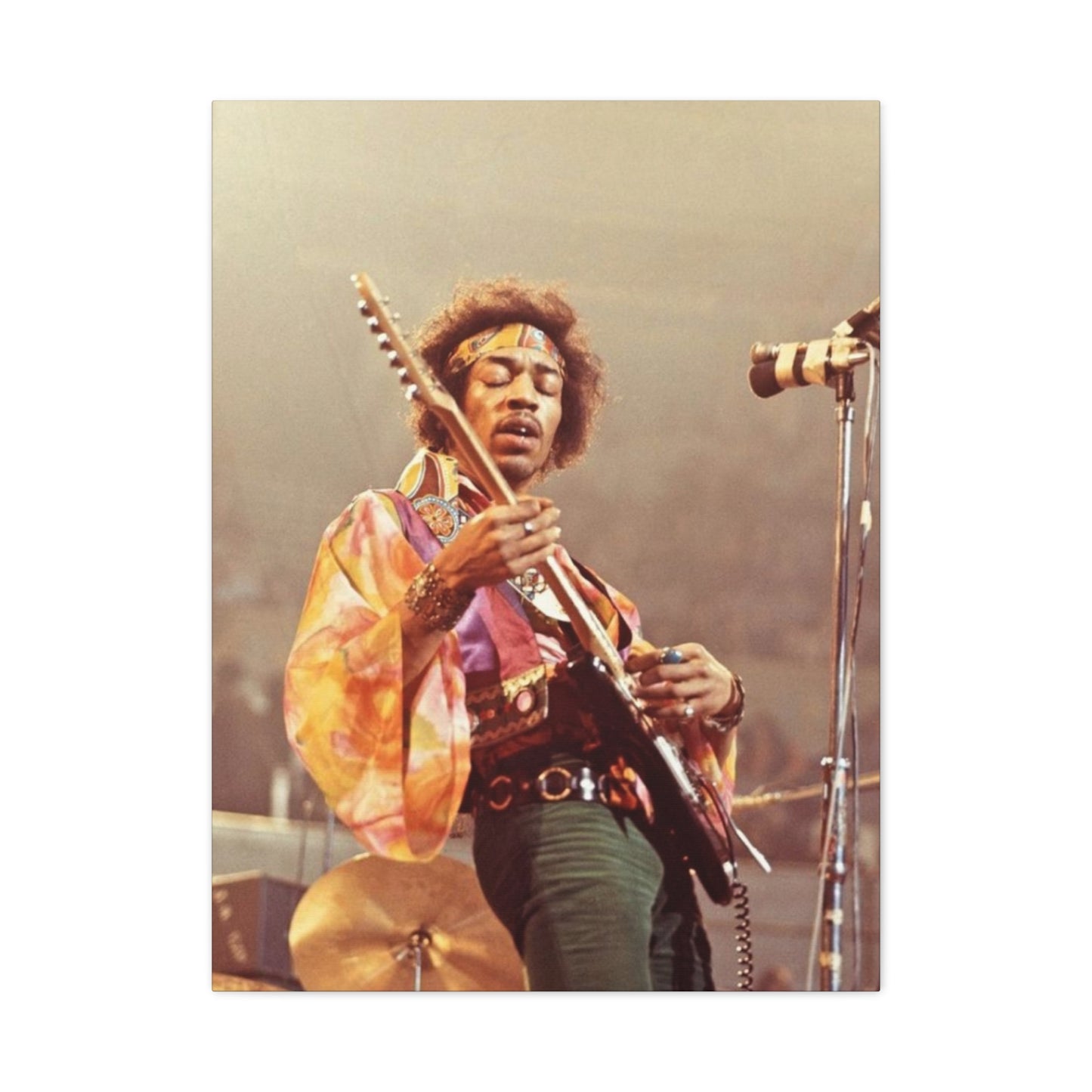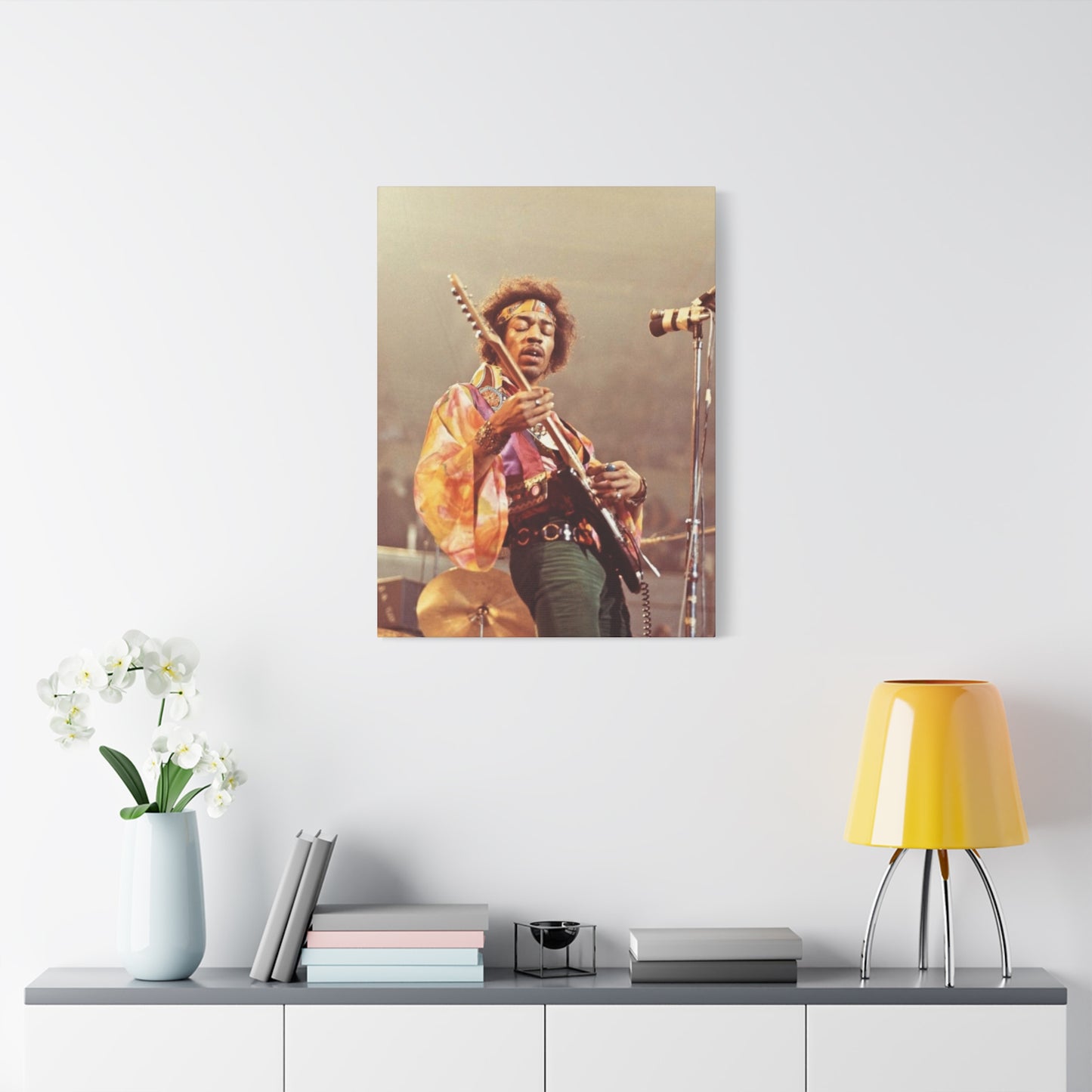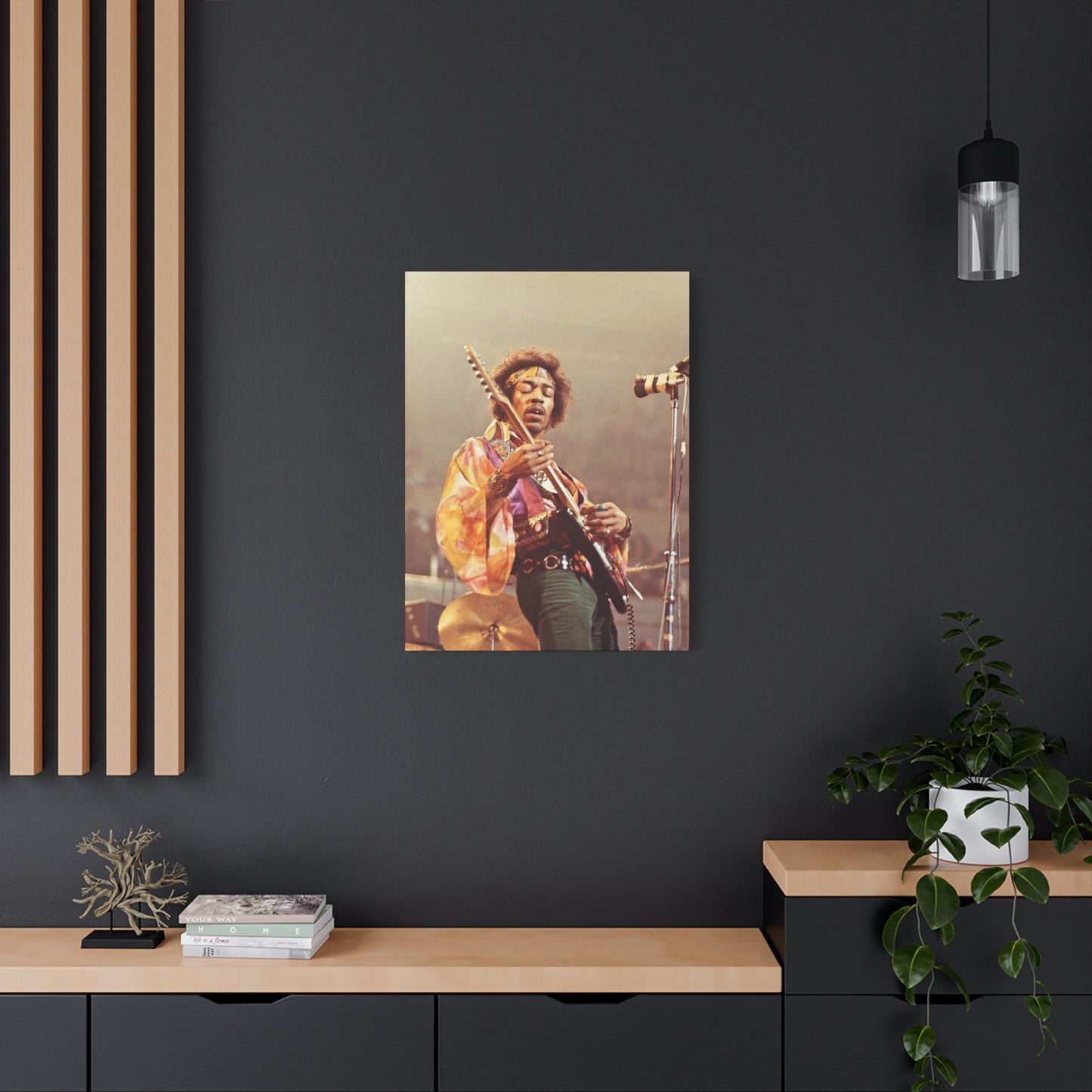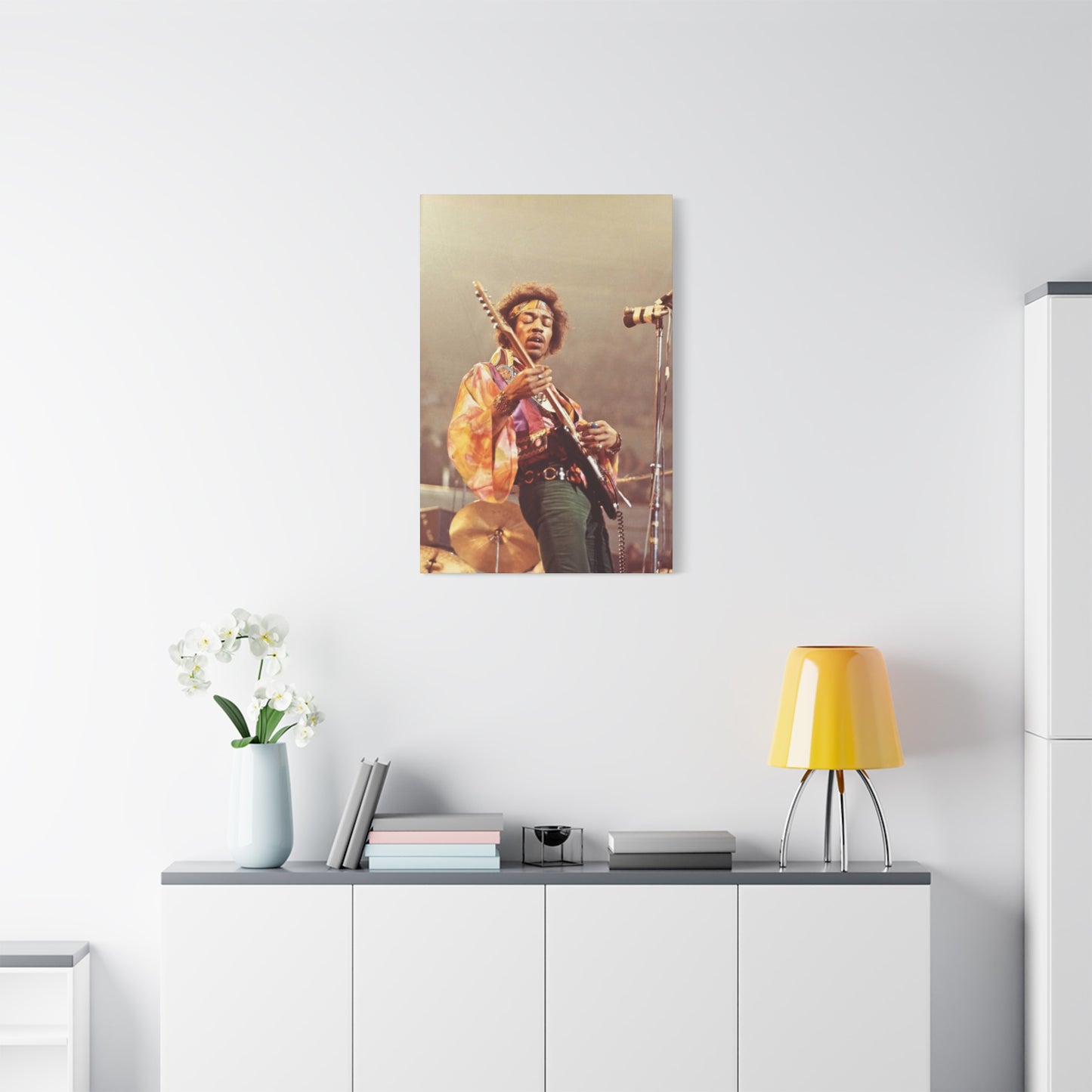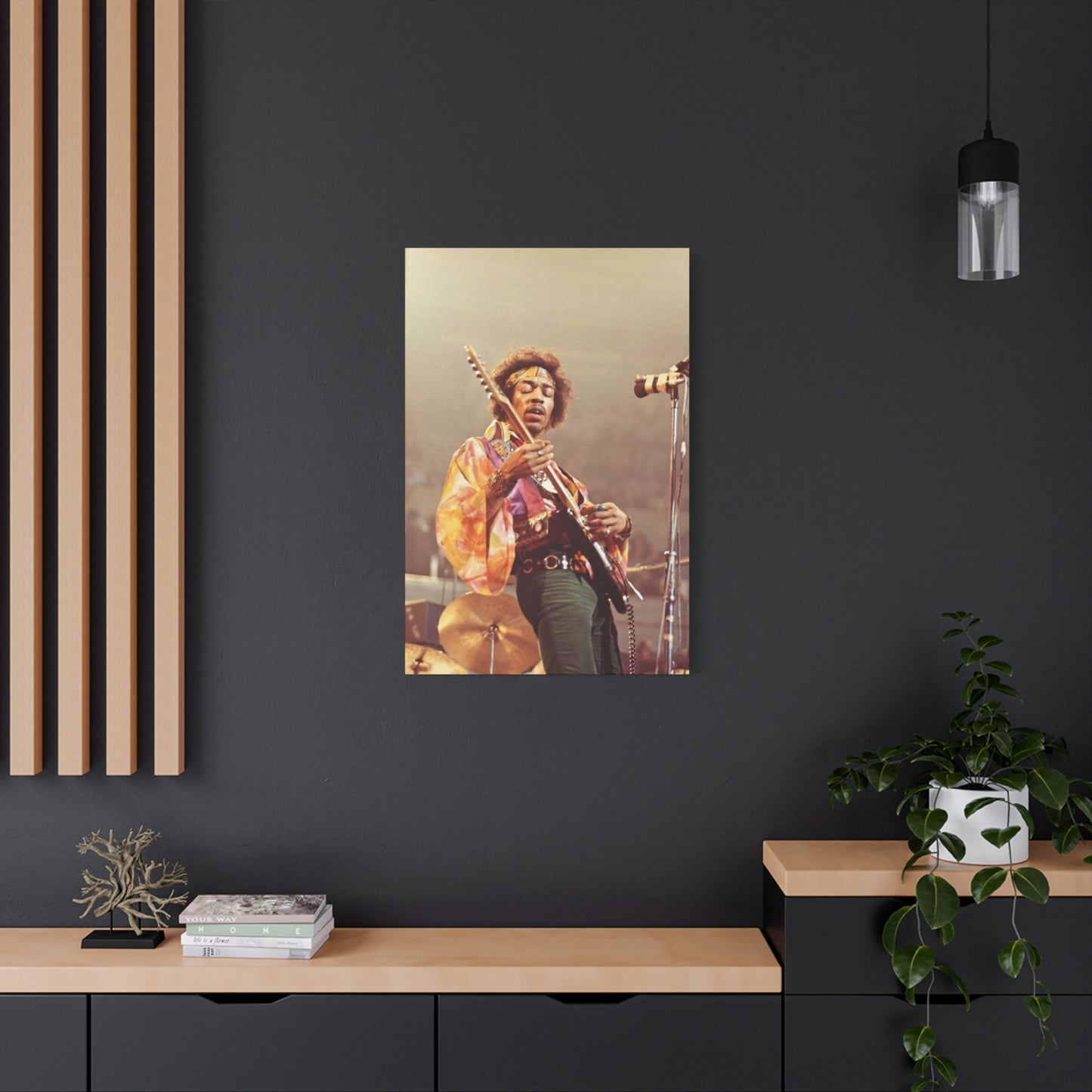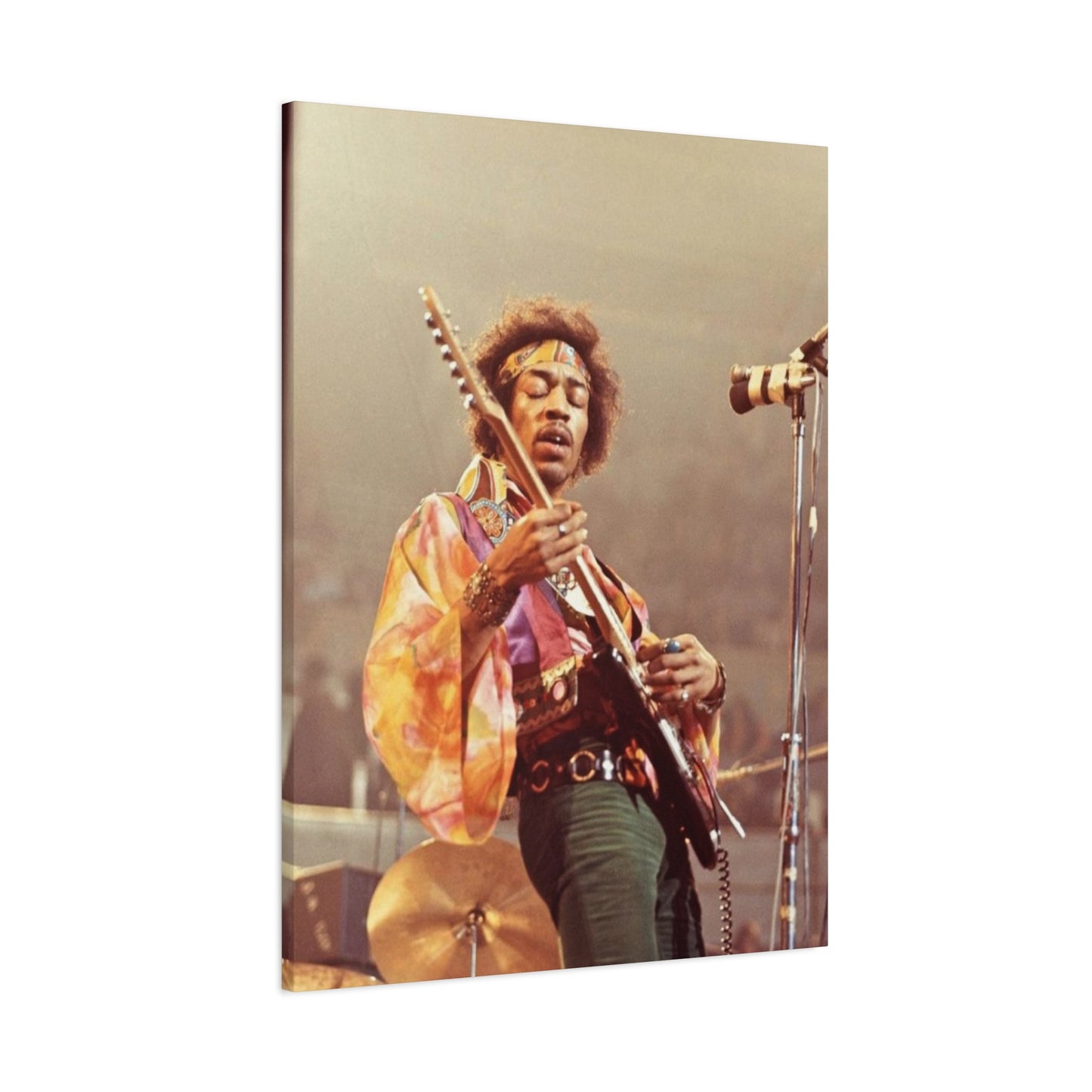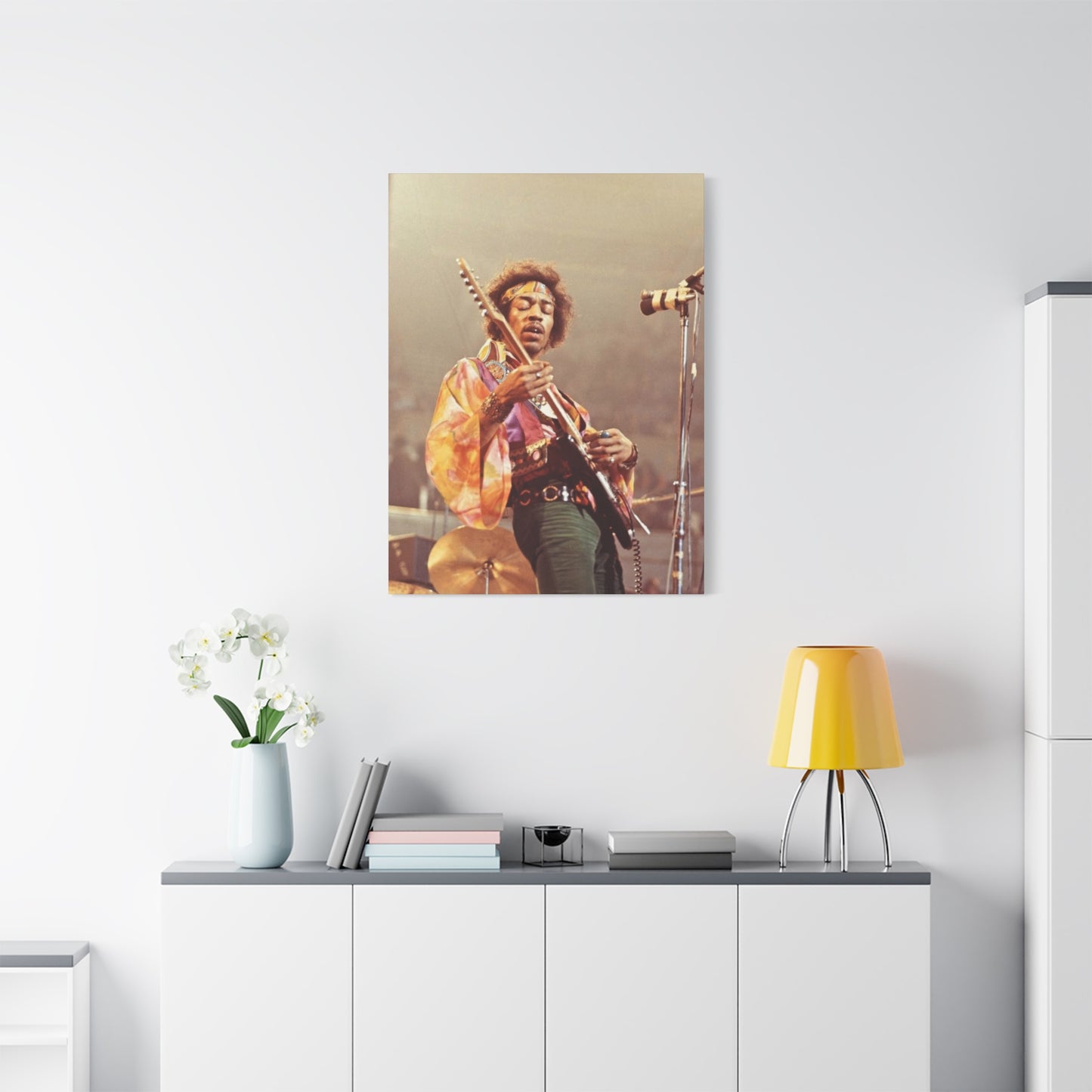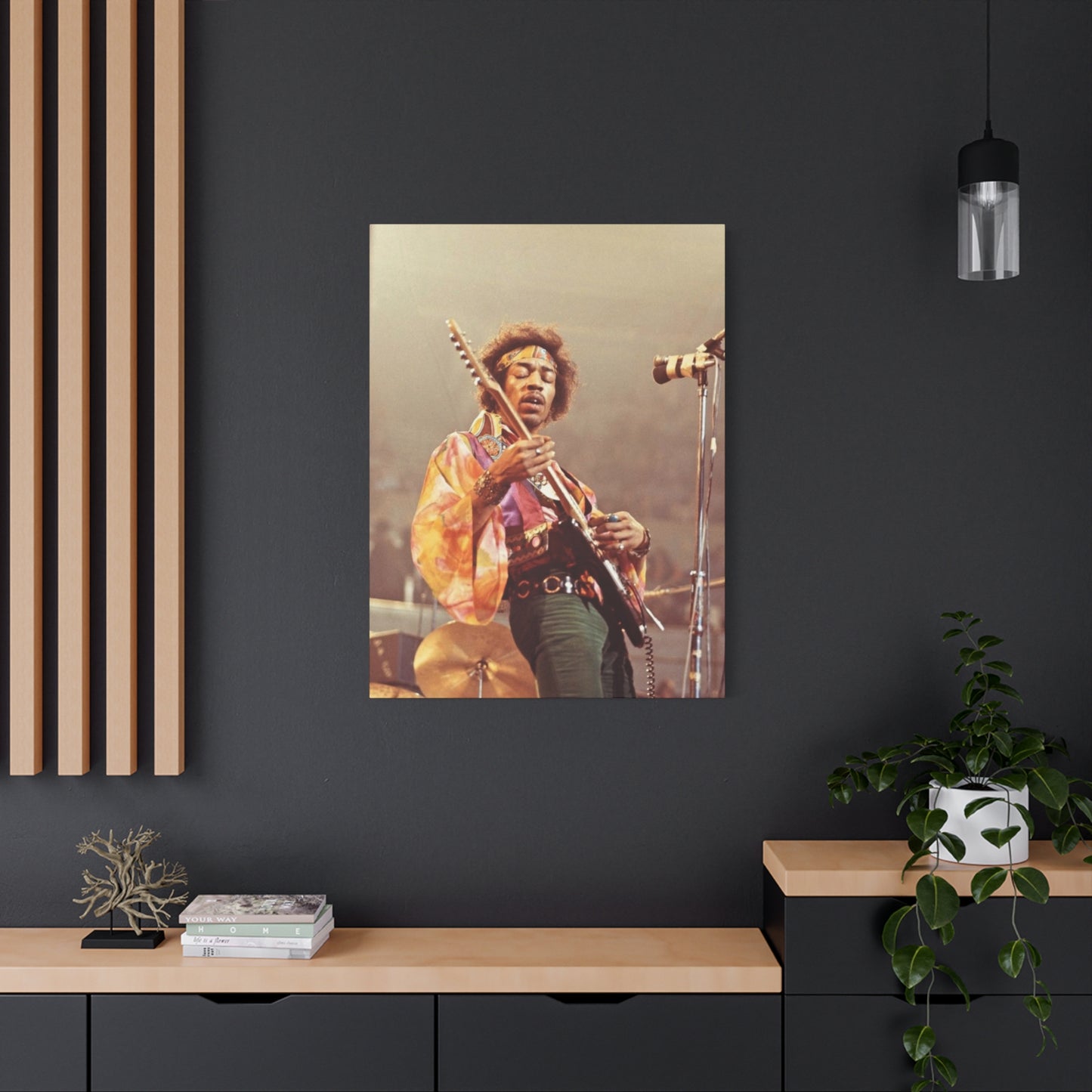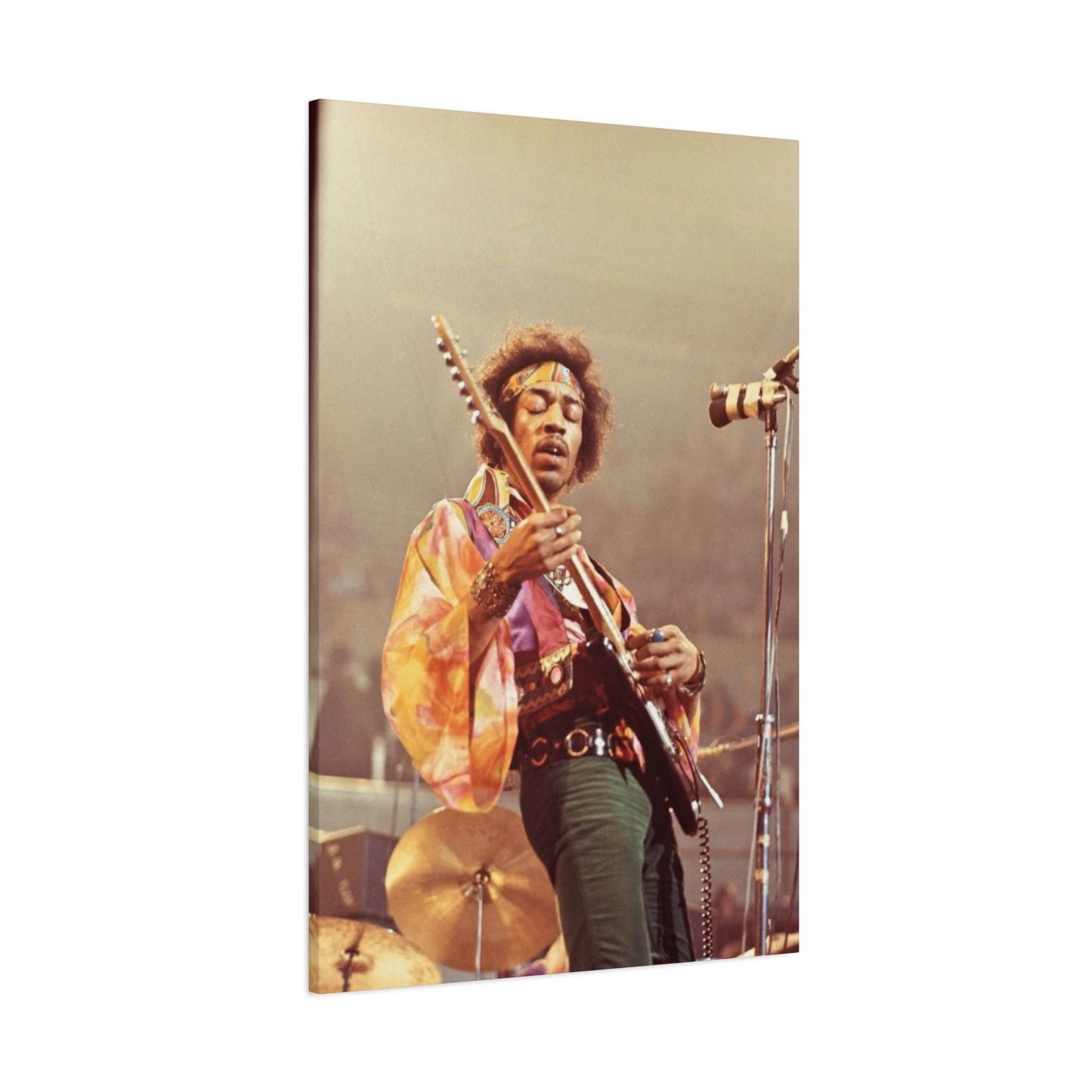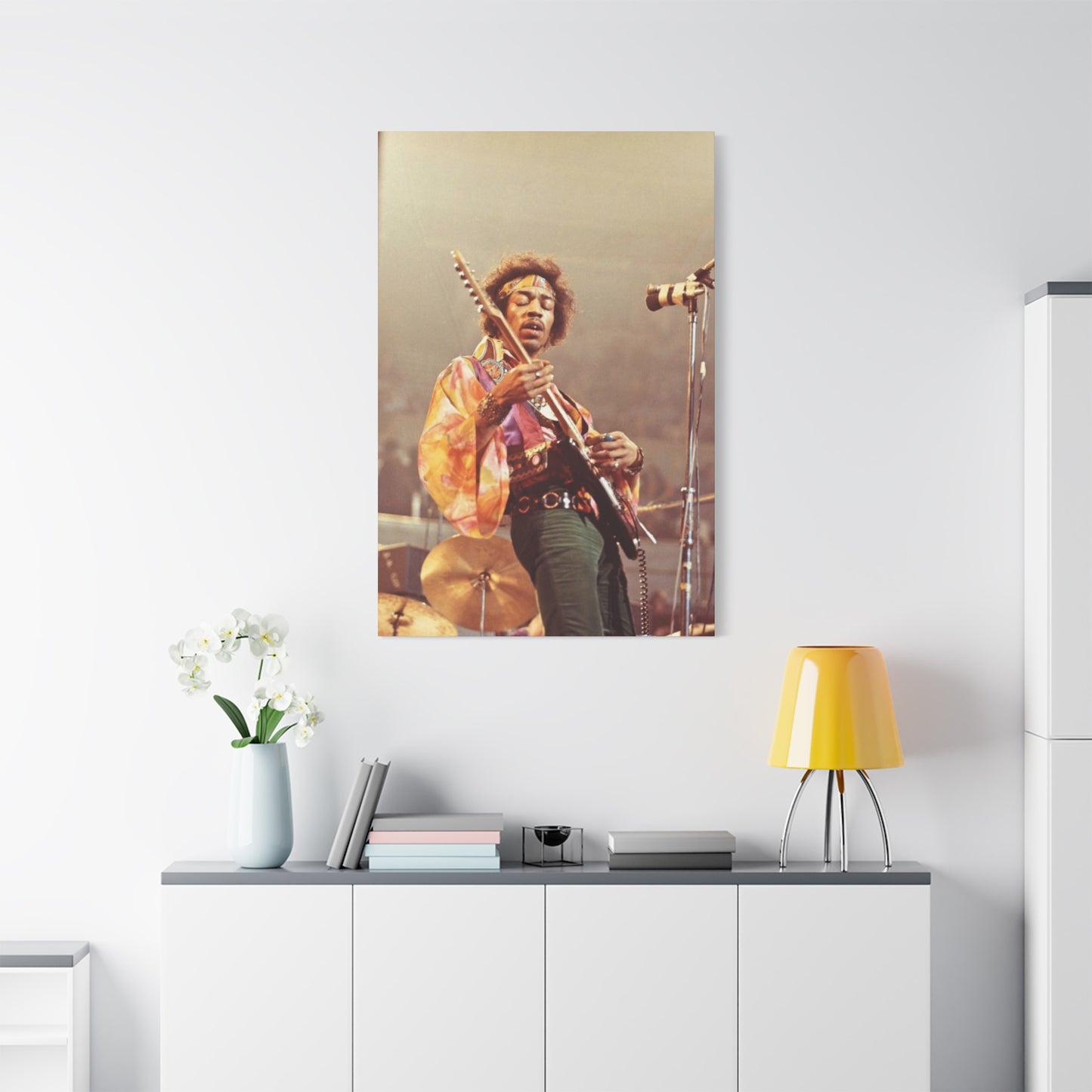A Definitive Exploration of Jimi Hendrix Playing Instrument Wall Art: Rock History in Your Living Space
Jimi Hendrix remains one of the most influential figures in the history of rock music, and his legacy continues to resonate through both sound and visual artistry. Canvas prints depicting Hendrix in the midst of a passionate performance capture more than just his likeness—they convey the raw energy, emotion, and unbridled creativity that defined his musical genius. For fans and collectors, these prints serve as both a tribute to a legendary artist and a dynamic element of modern home décor.
The appeal of Jimi Hendrix canvas prints lies in their ability to combine musical history with visual storytelling. Artists often portray him in iconic poses: guitar held high, fingers dancing across frets, body immersed in rhythm, and expressions of intense concentration or ecstatic abandon. The resulting artwork reflects the electric atmosphere of live rock performances, transporting viewers to the era when Hendrix redefined what the guitar could express. Bold colors, abstract brushwork, or even monochromatic designs highlight the intensity and movement of his performances, ensuring that each canvas makes a striking statement in any room.
From an interior design perspective, Hendrix performance canvases are versatile and impactful. They work seamlessly in contemporary living rooms, music studios, entertainment spaces, or personal collections, adding a sense of personality and artistic flair. Pairing these prints with minimalist furniture or industrial décor can create a striking focal point, while incorporating them into eclectic or retro-inspired spaces can reinforce a theme of musical heritage and cultural appreciation.
Moreover, these prints are not merely decorative—they celebrate innovation, rebellion, and artistic freedom. They remind viewers of the transformative power of music and the enduring influence of artists who challenge conventions. For anyone passionate about music or modern art, owning a Jimi Hendrix canvas print is a way to bring history, inspiration, and aesthetic sophistication into everyday life.
In essence, Jimi Hendrix musical performance canvas prints offer more than just visual appeal; they embody the spirit of creativity and revolution. As a piece of modern home decoration, they are both a tribute to one of rock music’s greatest legends and a statement of bold, artistic taste, making them an enduring choice for anyone seeking to merge music, culture, and design.
The Cultural Significance of Hendrix Imagery in Contemporary Spaces
The visual representation of this groundbreaking artist holds profound meaning in modern interior decoration. His influence transcended music, becoming a symbol of creative freedom and artistic rebellion that resonates with people across generations. When displayed in living spaces, these artistic representations serve multiple purposes beyond mere decoration.
The cultural impact of incorporating such imagery into residential or commercial spaces reflects a connection to musical history and countercultural movements. These visual pieces represent more than entertainment memorabilia; they embody a philosophy of breaking boundaries and challenging conventional norms. The guitarist's distinctive style, characterized by his innovative techniques and passionate performances, created a visual aesthetic that translates remarkably well to canvas formats.
Interior designers increasingly recognize the power of music-themed artwork in creating atmosphere and establishing character within rooms. The dynamic poses captured in performance photographs translate into compelling visual compositions that draw the eye and stimulate conversation. These decorative elements can transform ordinary walls into focal points that express personality and cultural awareness.
The timeless appeal of such artwork stems from the universal language of music and the enduring legacy of pioneering musicians. Younger generations continue discovering this revolutionary artist, ensuring that demand for related visual art remains strong. This sustained interest makes these decorative pieces excellent investments for both personal enjoyment and potential value appreciation.
Historical Context Behind Performance Photography Artwork
Understanding the era that produced these iconic images enhances appreciation for their artistic value. The late 1960s and early 1970s witnessed unprecedented musical experimentation and cultural transformation. Concert photography from this period captured not just performances but entire movements of social change and artistic innovation.
Photographers documenting live performances during this golden age of rock faced unique challenges. Limited lighting technology, unpredictable stage conditions, and the spontaneous nature of live music required exceptional skill and timing. The resulting images possess an authenticity and raw energy difficult to replicate in controlled studio environments.
Many celebrated photographs featuring this legendary guitarist were taken at historic venues and festivals that became landmarks in music history. These locations witnessed groundbreaking performances that redefined what was possible with electric guitar. The visual documentation of these moments preserved cultural history for future generations to study and appreciate.
The transition from concert photography to wall art represents an interesting evolution in how society values and preserves musical heritage. What began as documentary photography has transformed into collectible art appreciated for both historical significance and aesthetic quality. This transformation reflects broader changes in how contemporary culture views and commemorates artistic achievement.
Specific performance moments have become iconic through repeated reproduction in various media formats. Certain poses, expressions, and stage positions have achieved status as definitive representations of the artist's persona. These recognizable images form the foundation for the most popular canvas print designs available today.
Different Artistic Styles Available for Wall Displays
The market offers diverse interpretations of performance imagery ranging from photorealistic reproductions to abstract artistic renderings. Each style serves different aesthetic preferences and interior design schemes. Understanding these variations helps buyers select pieces that best complement their spaces and personal tastes.
Photorealistic canvas prints preserve the original photography's integrity, maintaining historical accuracy and documentary quality. These reproductions appeal to purists who value authenticity and want to display images as close to original photographs as possible. High-quality printing techniques can capture remarkable detail, from the texture of instrument finishes to the intensity of facial expressions.
Pop art interpretations transform classic photographs into vibrant, stylized compositions using bold colors and graphic elements. This approach, popularized by artists in the 1960s, creates visually striking pieces that make strong design statements. The high contrast and saturated colors typical of this style work particularly well in modern and contemporary interior settings.
Black and white presentations offer timeless elegance and focus attention on composition, form, and emotional expression. By removing color, these versions emphasize the subject's energy and the photograph's technical qualities. Monochrome prints integrate seamlessly into virtually any color scheme and maintain a classic, sophisticated appearance.
Abstract and artistic renderings reinterpret original photographs through various creative filters and techniques. These versions might incorporate paint effects, digital manipulation, or mixed media approaches. Such pieces appeal to those seeking unique interpretations that function as standalone artwork rather than mere reproductions.
Silhouette and outline designs reduce images to essential shapes and forms, creating minimalist representations with powerful visual impact. These simplified versions work exceptionally well in spaces where subtle decoration is preferred over bold statements. The clean lines and reduced complexity suit modern minimalist aesthetics.
Customization Options and Personalization Opportunities
Many providers offer customization services that transform standard prints into unique personal expressions. These options increase artwork's personal significance and ensure perfect integration with specific spaces.
Custom sizing allows precise fitting to available wall spaces and proportional coordination with furniture. Made-to-order dimensions ensure optimal visual impact within specific architectural contexts. Custom sizing particularly benefits those with unusual wall dimensions or specific design requirements.
Color adjustment services can modify print palettes to better match existing decor. Enhancing certain tones while muting others creates harmonious color relationships with room elements. Color customization particularly benefits those with specific color schemes they want artwork to complement.
Personal photograph printing allows commissioning canvas prints from individual photographs. Those who captured their own concert photographs or possess unique images can have them professionally printed on canvas. Personal prints carry additional sentimental value beyond commercial reproductions.
Text addition incorporates names, dates, lyrics, or quotes directly into artwork compositions. Personalized text transforms generic prints into commemoration pieces marking specific events or expressing individual connections. Text should be carefully integrated to enhance rather than detract from visual compositions.
Mixed media combinations incorporate multiple printing techniques, hand-painting, or applied embellishments. These enhanced pieces blur lines between prints and original artwork. Mixed media treatments create truly unique pieces unavailable through standard production methods.
Authentication and Quality Assurance Indicators
Distinguishing quality products from inferior alternatives requires understanding authentication markers and quality indicators. Educated buyers can identify superior options and avoid disappointments.Certificates of authenticity document limited edition status and production details. These certificates provide provenance records important for resale value and collection documentation. Reputable publishers include certificates with all limited-edition releases.
Edition numbering on limited prints indicates position within production runs. Standard notation shows individual number followed by total run size. Lower numbers typically carry slight premium values among collectors.Publisher information and logos identify authorized reproductions versus unauthorized copies. Official licenses ensure quality standards and support original photographers or estates. Purchasing from authorized sources guarantees authenticity and ethical production.
Material specifications should be clearly stated, including canvas type, ink formulas, and construction methods. Transparent providers detail all technical aspects allowing informed purchasing decisions. Vague or missing specifications may indicate quality concerns.Return policies and satisfaction guarantees demonstrate confidence in product quality. Reputable sellers offer reasonable return windows allowing inspection and approval. Strong guarantees reduce purchasing risks.
Alternative Display Methods and Mounting Solutions
Beyond traditional hanging, various display methods offer creative presentation options suited to different spaces and preferences. Exploring alternatives expands decorating possibilities.Easel displays provide portable, flexible presentation options requiring no wall mounting. Floor easels work well for temporary displays, renters unable to modify walls, or those who enjoy frequently rearranging spaces. Easel displays suit both small accent pieces and substantial statement works.
Leaning arrangements position artwork against walls on mantels, shelves, or floor level. This casual approach creates relaxed, effortless aesthetics popular in contemporary design. Leaning works particularly well for oversized pieces that might overwhelm when hung.Rail systems with adjustable hanging mechanisms allow easy repositioning and reconfiguration without wall damage. These commercial-grade systems particularly suit gallery walls or collections that evolve over time. Rail systems distribute weight evenly, safely supporting multiple pieces.
Floating shelf displays integrate artwork with three-dimensional objects creating curated vignettes. Combining prints with books, plants, and decorative items adds depth and context. Shelf displays work well in smaller spaces where wall mounting might overwhelm.Projection mounting creates slight separation between artwork and walls, adding dimension and shadow effects. Raised mounting draws attention and creates premium presentations. Projection mounting particularly enhances larger statement pieces.
Impact of Music Legacy on Contemporary Culture
The enduring influence of revolutionary musicians extends far beyond music into fashion, visual arts, and cultural attitudes. This broader impact explains sustained demand for related artwork.Fashion innovations and distinctive personal style established visual identities that remain influential decades later. Clothing choices, accessories, and grooming styles challenged conventions and established new aesthetics. These style elements frequently appear in performance imagery, adding layers of cultural significance.
Social activism and countercultural involvement connected music with broader movements for social change. Performances often carried political messages and challenged establishment values. This activist dimension adds depth to performance imagery beyond pure entertainment.Technical innovation and experimentation expanded possibilities within musical genres. New techniques and approaches influenced countless subsequent musicians. Performance images capture moments of creative breakthrough that changed musical history.
Cross-cultural influences and fusion of diverse traditions created unprecedented artistic syntheses. Drawing from varied musical and cultural backgrounds produced revolutionary hybrid styles. This cultural mixing reflected and accelerated broader social integration.Generational transmission ensures continuing discovery by new audiences. Parents sharing musical passions with children perpetuate legacies across decades. This ongoing introduction of classic artists to new generations sustains demand for related merchandise and artwork.
Commercial Spaces and Business Applications
Beyond residential use, performance artwork serves important functions in commercial environments where it establishes ambiance and reinforces brand identities. Understanding commercial applications reveals additional market segments.Music venues naturally incorporate artist imagery creating atmospheric connections to musical heritage. Bars, clubs, and concert halls use such artwork to establish credentials and create appropriate moods. These commercial applications often favor larger formats with dramatic impact.
Recording studios feature music-related artwork acknowledging influences and inspiring creativity. Studio environments benefit from imagery that celebrates musical excellence and innovation. Such decoration reinforces studio brand identities and impresses clients.Retail environments selling music-related merchandise use artwork as both decoration and marketing tool. Record stores, instrument shops, and memorabilia dealers create immersive shopping experiences through comprehensive artist imagery. Retail applications often emphasize recognizable, commercially successful images.
Restaurants and cafes use music-themed artwork to establish distinctive personalities and target specific demographics. Establishments courting customers with particular musical tastes use related artwork signaling their cultural affiliations. Restaurant applications typically favor pieces that complement rather than dominate dining experiences.Office environments incorporate artwork reflecting company cultures and values. Creative industries particularly embrace music-related imagery symbolizing innovation and nonconformist thinking. Office applications balance professional appearances with personality expression.
Digital Versus Physical Art Considerations
The rise of digital displays creates alternatives to traditional physical artwork. Understanding relative advantages helps determine appropriate applications for each format.Physical artwork provides tangible presence and material qualities impossible to replicate digitally. Canvas texture, dimensional depth, and unchanging consistency offer certainty and permanence. Physical pieces require no electricity and never experience technical failures.
Digital displays offer flexibility and variety, allowing frequent image changes from vast libraries. Digital frames can showcase entire collections rather than single pieces. This versatility appeals to those enjoying regular environmental changes.Investment and collectibility favor physical artwork with established authenticity and provenance. Physical pieces can appreciate in value and function as investments. Digital displays represent technology purchases rather than art investments.
Energy consumption and environmental impact differ significantly between formats. Physical artwork has no ongoing energy requirements once installed. Digital displays consume electricity continuously, contributing to household energy costs.Initial costs favor digital displays for those wanting variety, while physical artwork represents better long-term value for those committed to specific images. Cost comparisons should consider total ownership expenses over expected lifespans.
Framing Styles and Presentation Options
Frame selection significantly impacts artwork appearance and integration with interior design styles. Understanding framing options ensures complementary presentations.Gallery wraps with no visible frames create contemporary, minimalist presentations. Canvas extending around edges produces three-dimensional objects rather than flat wall hangings. Gallery wraps suit modern interiors and those preferring understated presentations.
Floating frames create separation between canvas and frame, adding dimension and visual interest. These frames attach to canvas edges while leaving small gaps visible. Floating frames combine protection of traditional framing with contemporary aesthetic sensibilities.Traditional wooden frames provide classic presentations suited to formal interiors. Wood choices range from light natural finishes to dark stained options. Traditional frames offer maximum protection and complement period furnishings.
Metal frames deliver sleek, modern appearances that suit industrial and contemporary design schemes. Aluminum and steel frames provide durability with minimal visual weight. Metal framing particularly complements black and white photography.Ornate decorative frames add visual interest and draw attention to artwork. These elaborate options suit eclectic or maximalist interiors. Decorative frames should complement rather than overwhelm artwork.
Storage and Protection During Non-Display Periods
Proper storage protects artwork during moves, renovations, or collection rotations. Appropriate storage methods prevent damage and preserve value.Climate-controlled environments prevent damage from temperature extremes and humidity fluctuations. Storage areas should maintain conditions similar to display environments. Climate control particularly matters for valuable pieces and long-term storage.
Protective wrapping using acid-free materials prevents surface damage and contamination. Specialized art storage materials protect without causing degradation. Multiple protection layers guard against physical impacts and environmental exposure.Vertical storage prevents pressure damage that occurs when pieces stack horizontally. Storing upright with adequate support maintains canvas tension and prevents warping. Vertical storage requires adequate space but provides superior protection.
Separation between stored pieces prevents surface contact that might cause transfer or abrasion. Individual wrapping or padding maintains safe distances. Proper separation particularly matters with multiple stored pieces.Inventory documentation with photographs and descriptions facilitates insurance claims and ensures nothing gets forgotten. Detailed records track stored pieces and their conditions. Thorough documentation proves valuable for insurance and estate planning purposes.
Shipping and Handling Considerations
Transporting canvas prints requires care to prevent damage during transit. Understanding shipping requirements ensures safe delivery.Packaging quality determines survival likelihood during shipping. Professional packaging uses multiple protection layers including corner protectors, bubble wrap, and rigid outer containers. Adequate packaging costs increase shipping expenses but prevent losses.
Insurance coverage protects against transit damage or loss. Declared values should reflect replacement costs including shipping. Insurance provides recourse if damage occurs despite proper packaging.Carrier selection balances cost, speed, and reliability. Premium carriers typically provide better tracking and handling. Carrier choice should reflect artwork value and delivery urgency.
Tracking services provide shipment visibility and delivery confirmation. Real-time tracking allows monitoring progress and identifying delays. Tracking particularly matters for valuable pieces.Delivery requirements may include signature confirmation or special handling instructions. Ensuring recipient availability prevents extended carrier storage. Clear delivery instructions prevent confusion and delays.
Legal and Copyright Considerations
Understanding intellectual property rights ensures ethical purchasing and prevents legal complications. Copyright awareness protects buyers and respects creator rights.Original photography remains copyrighted protecting photographers' economic and moral rights. Unauthorized reproduction violates these rights regardless of subject matter. Purchasing from licensed sources ensures legal compliance.
Publicity rights protect individuals' commercial image use. Using someone's likeness for commercial purposes typically requires permission. Established artists' estates carefully control image licensing.Fair use exceptions allow limited unlicensed use under specific circumstances. Educational and transformative uses may qualify for fair use protection. Fair use determinations involve complex legal analysis beyond most consumers' expertise.
Licensed reproductions include royalty payments compensating rights holders. Official licensing benefits original photographers and artist estates. Licensed products typically identify authorization clearly.Unauthorized reproductions deprive creators of compensation and may expose buyers to legal risks. Quality concerns often accompany unauthorized products. Legitimate sourcing protects all parties and ensures quality standards.
Investment Potential and Collectibility Factors
While primarily decorative, some canvas prints appreciate in value becoming legitimate investments. Understanding collectibility factors identifies pieces with investment potential.Limited editions with low production numbers and high demand may appreciate significantly. Scarcity drives collectibility among enthusiasts seeking complete collections. Investment potential increases with restricted availability.
Artist and photographer reputations influence value appreciation potential. Works by celebrated photographers command premiums and maintain value. Researching creator backgrounds informs investment decisions.Historical significance of captured moments affects long-term value. Images documenting important events or representing cultural milestones tend to appreciate. Historical context adds layers of meaning increasing desirability.
Condition maintenance critically impacts resale values. Well-preserved pieces command significantly higher prices than damaged examples. Proper care protects investment value.Market trends and cultural currents influence demand and pricing. Periodic renewed interest drives price increases. Understanding broader cultural trends helps anticipate value movements.
Psychological Benefits of Music-Themed Decor
Beyond aesthetics, music-related artwork provides psychological benefits enriching daily life. Understanding these effects validates decoration choices.Personal identity expression through decorative choices reinforces self-concept and communicates values. Displaying music artwork announces cultural affiliations and personal passions. This expression contributes to psychological wellbeing through authentic self-presentation.
Nostalgia and memory activation trigger positive emotions associated with musical experiences. Artwork depicting beloved artists reconnects viewers with meaningful life periods. These nostalgic connections provide comfort and continuity.Inspiration and motivation derived from images of admired artists encourage personal excellence. Seeing representations of accomplished figures can boost determination and creativity. Inspirational artwork supports goal pursuit and personal development.
Conversation facilitation through distinctive artwork strengthens social connections. Shared musical interests revealed through decoration create bonding opportunities. Social interaction benefits contribute significantly to overall wellbeing.Stress reduction occurs when engaging with meaningful, aesthetically pleasing environments. Beautiful spaces promoting positive associations help manage daily stressors. Environmental enhancement through thoughtful decoration supports mental health.
Seasonal and Temporary Display Strategies
Rotating artwork seasonally or for special occasions maintains environmental freshness and maximizes collection enjoyment. Strategic rotation strategies enhance ongoing appreciation.Seasonal color coordination aligns artwork with changing seasonal palettes throughout the year. Warmer tones suit autumn and winter while cooler shades complement spring and summer. Seasonal rotation creates dynamic environments that evolve naturally.
Holiday and celebration theming incorporates special artwork for birthdays, anniversaries, or commemorative occasions. Temporary displays marking significant dates add festive touches. Celebration-specific artwork increases occasion significance.Mood-based selection allows matching artwork to desired emotional atmospheres. Energetic pieces suit productive periods while calmer works support relaxation phases. Responsive rotation meets changing psychological needs.
Collection showcasing through systematic rotation ensures all pieces receive display time. Predetermined schedules prevent favorites from monopolizing wall space. Fair rotation maximizes investment value across collections.Guest consideration allows customizing displays for visitors with known preferences. Thoughtful artwork selection demonstrates hospitality and personal attention. Guest-oriented displays strengthen relationships and create memorable visits.
Educational Value and Historical Learning
Music-themed artwork serves educational purposes, sparking interest in cultural history and musical development. These learning opportunities add intellectual dimensions to decorative objects.Musical history exploration begins with curiosity about artists depicted in artwork. Visual interest motivates research into careers, influences, and cultural contexts. Decoration becomes gateway to historical learning.
Cultural context understanding develops through investigating periods and movements represented in artwork. Learning about countercultural movements, social changes, and artistic innovations enriches appreciation. Historical context transforms decoration into educational resources.Technical appreciation grows from examining instruments, equipment, and performance techniques visible in imagery. Viewers develop understanding of musical technologies and playing methods. Technical interest deepens engagement with both art and music.
Artistic influence tracing reveals connections between artists and their successors. Understanding influence chains illuminates musical evolution. Recognition of influence patterns enriches listening experiences.Cross-generational dialogue emerges when younger viewers ask questions about depicted artists. Shared exploration of musical history strengthens family bonds. Intergenerational learning benefits all participants.
Acoustic and Sensory Room Design Integration
Sound reflection properties of canvas-covered walls differ from bare surfaces, potentially improving room acoustics. Canvas materials absorb some sound frequencies, reducing harsh echoes in rooms with many hard surfaces. Strategic artwork placement can address acoustic problems while providing visual interest.Texture variations between canvas and wall surfaces create subtle visual depth that engages multiple senses. The dimensional quality of stretched canvas adds tactile interest even when not directly touched. Multi-sensory engagement creates richer environmental experiences than purely visual decoration.
Music listening spaces benefit from coordinated visual and auditory elements reinforcing thematic consistency. Displaying performance imagery in dedicated listening rooms creates immersive environments celebrating musical appreciation. Synchronized sensory elements enhance focus and enjoyment during listening sessions.Lighting design considerations account for both artwork illumination and room functionality. Adjustable lighting systems allow optimizing visibility for different activities while properly showcasing artwork. Integrated lighting design balances competing demands elegantly.
Material coordination extends beyond artwork to encompass furniture, flooring, and window treatments. Canvas texture relates to upholstery fabrics, wood finishes, and other tactile elements. Comprehensive material planning creates harmonious sensory environments.
Social Media and Digital Sharing Considerations
Contemporary display practices often include sharing interior spaces through social media platforms. Understanding digital presentation helps maximize artwork's photographic appeal.Photography-friendly compositions consider how spaces appear in photographs versus direct viewing. Elements that photograph well may differ from those most appealing in person. Designing with photography in mind accommodates modern sharing practices.
Lighting for photography requires different considerations than ambient lighting for daily use. Avoiding glare and reflections in photographs may require adjusting artwork angles or lighting sources. Photography-optimized lighting improves digital sharing quality.Background context in photographs affects how artwork appears in shared images. Coordinating surrounding elements ensures artwork remains focal points in photographs. Thoughtful styling enhances social media presentation effectiveness.
Digital color accuracy challenges arise from screen variations and photographic color shifts. Colors appearing one way in person may photograph differently. Understanding these limitations manages expectations for digital sharing.Privacy considerations when sharing interior photographs require thoughtful decisions about what appears in images. Protecting personal information while showcasing design choices balances sharing enthusiasm with security concerns. Selective framing controls what others see.
Multi-Generational Appeal and Family Significance
Artwork transcending generational preferences creates shared family touchstones appreciated across age groups. Universal appeal strengthens artwork's long-term value within households.Cross-generational musical influence ensures legendary artists remain relevant to multiple age groups. Parents who experienced original performances share enthusiasm with children discovering music decades later. This continuity creates family traditions around musical appreciation.
Historical education opportunities emerge naturally when family members discuss depicted artists and eras. Grandparents sharing first-hand memories with grandchildren preserves living history. Artwork catalyzes meaningful intergenerational conversations.Inheritance planning for meaningful artwork ensures pieces pass to appreciative family members. Discussing artwork significance prepares next generations to value and preserve pieces. Thoughtful succession planning maintains family connections across generations.
Shared aesthetic appreciation develops when family members collectively select and display artwork. Collaborative decorating decisions build consensus and shared ownership. Joint investment in environmental design strengthens family bonds.Memory creation through distinctive home environments leaves lasting impressions on children growing up surrounded by meaningful artwork. Adults often recall childhood homes through specific decorative elements. Thoughtfully chosen artwork contributes to formative experiences shaping lifelong memories.
Technological Authentication and Verification Methods
Modern technology enables sophisticated authentication verifying artwork legitimacy and quality. Understanding available technologies protects buyers from fraud.Holographic security labels provide visual authentication impossible to replicate accurately. These sophisticated markings identify genuine products from authorized sources. Checking for proper security features confirms authenticity.Blockchain certification creates permanent, tamper-proof ownership records for limited editions. Distributed ledger technology prevents forgery and establishes clear provenance. Blockchain authentication represents cutting-edge protection for digital and physical artwork.
QR code verification links physical products to digital databases confirming production details. Scanning codes accesses information about materials, production dates, and edition numbers. QR authentication provides instant verification using smartphones.Watermark integration in prints provides subtle authentication markers visible under specific conditions. Hidden watermarks deter counterfeiting while remaining unobtrusive during normal viewing. Watermark verification requires knowing what to look for and how to reveal hidden markers.Certificate databases maintained by publishers allow verification of documented claims. Cross-referencing certificate numbers against official records confirms authenticity. Database verification particularly matters for valuable limited editions.
Environmental Sustainability and Eco-Conscious Production
Growing environmental awareness influences purchasing decisions as consumers seek sustainably produced artwork. Understanding eco-friendly production methods guides responsible choices.Sustainable canvas materials including organic cotton and recycled polyester reduce environmental impact. Eco-conscious production uses materials with lower carbon footprints and minimal chemical processing. Material certifications verify sustainability claims.
Water-based inks reduce toxic chemical use compared to traditional solvent-based formulations. Eco-solvent and latex inks provide excellent quality while minimizing environmental harm. Ink selection significantly impacts production's ecological footprint.Renewable energy powered production facilities reduce carbon emissions associated with manufacturing. Solar and wind powered facilities demonstrate commitment to sustainability. Energy source transparency reveals environmental responsibility.
Local production reduces transportation emissions and supports regional economies. Sourcing artwork from nearby producers minimizes shipping distances and associated carbon costs. Local purchasing benefits communities while protecting environment.Recyclable packaging materials reduce waste from product delivery. Biodegradable and reusable packaging options minimize environmental impact. Packaging choices reflect overall environmental commitment.Forest Stewardship Council certification ensures wood components come from responsibly managed forests. FSC certification guarantees sustainable forestry practices protecting ecosystems. Certified materials support conservation efforts.
Insurance and Asset Protection Strategies
Valuable artwork requires appropriate insurance coverage protecting against loss, damage, or theft. Understanding insurance options safeguards investments.Homeowners insurance often provides limited coverage for artwork, typically insufficient for valuable pieces. Standard policies may cap art coverage at low amounts requiring additional protection. Reviewing existing coverage reveals protection gaps.Scheduled personal property endorsements specifically list and value individual pieces. Detailed inventories with photographs and appraisals establish coverage amounts. Scheduled coverage ensures adequate protection for valuable items.
Specialized art insurance policies provide comprehensive coverage designed specifically for artwork. These policies address unique risks and concerns affecting art collections. Specialized coverage offers superior protection compared to general homeowners policies.Appraisal requirements establish accurate values for insurance purposes. Professional appraisals document authenticity, condition, and market value. Current appraisals ensure appropriate coverage amounts as values change.Documentation including purchase receipts, certificates, and photographs supports insurance claims. Comprehensive records prove ownership and establish values. Maintaining organized documentation facilitates smooth claim processes if losses occur.
Comparative Analysis of Production Sources
Understanding differences between production sources helps identify quality providers matching specific needs and budgets. Comparative evaluation leads to informed decisions.Independent artists producing small batches offer uniqueness and direct creator relationships. Artist-direct purchases support individual creators and often provide customization options. These sources suit buyers valuing artisan production and personal connections.Established art publishers provide quality consistency and broad selection from recognized artists. Published editions offer assurance of materials and production standards. Publishers suit buyers prioritizing reliability and variety.
Online marketplaces aggregate offerings from multiple sources providing vast selection and competitive pricing. Marketplace purchasing allows comparison shopping but requires careful quality evaluation. These platforms suit price-conscious buyers willing to research individual sellers.Custom printing services transform personal photographs into canvas prints. These providers enable unique personalization impossible with stock images. Custom services suit those with original photographs or specific creative visions.Mass retailers offer affordable options with quick availability but potentially compromised quality. Budget-friendly sources provide accessibility but may sacrifice materials or craftsmanship. Retail sources suit temporary displays or experimental purchases.
Complementary Decor Elements and Styling
Coordinating artwork with surrounding decor elements creates cohesive environments maximizing aesthetic impact. Thoughtful styling elevates overall presentations.Furniture selection considering artwork establishes visual relationships between major design elements. Color coordination and stylistic consistency create harmonious spaces. Furniture serving as artwork backdrops should complement without competing.
Lighting fixtures visible near artwork should coordinate stylistically while providing proper illumination. Fixture designs range from invisible recessed lighting to decorative statement pieces. Lighting choices affect both functionality and aesthetics.Textile coordination including curtains, upholstery, and throw pillows creates unified color stories. Repeating colors from artwork throughout textiles strengthens visual connections. Textile selection offers opportunities for introducing complementary or contrasting elements.
Decorative accessories like vases, sculptures, and books can echo artwork themes without literal repetition. Subtle thematic connections create sophisticated layered designs. Accessory selection requires restraint preventing visual clutter.Plant integration softens hard surfaces and introduces organic elements balancing manufactured artwork. Living plants add dimension and movement to static wall displays. Strategic plant placement enhances rather than obscures artwork.
Cultural Variations in Art Appreciation and Display
Global differences in aesthetic preferences and display conventions affect artwork selection and presentation. Cultural awareness broadens perspective and informs decisions.Western minimalism emphasizes negative space and restrained decoration. This aesthetic favors fewer, larger pieces with ample surrounding space. Minimalist approaches value simplicity and intentionality.Maximalist traditions embrace abundant decoration and layered complexity. These approaches celebrate visual richness and eclectic combinations. Maximalist spaces accommodate extensive collections and bold combinations.
Regional color preferences reflect cultural associations and climate influences. Warm climates often favor cool colors while cold regions embrace warming tones. Cultural color symbolism affects palette reception differently across societies.Religious and spiritual considerations influence appropriateness of certain imagery in some cultures. Respectful awareness of these sensitivities guides selection for multicultural households. Cultural sensitivity demonstrates respect and awareness.Traditional versus contemporary preferences vary significantly across cultures and generations. Some cultures maintain stronger attachments to classical aesthetics while others embrace modern innovations. Understanding these variations informs global design perspectives.
Restoration and Conservation of Aging Prints
Over time, canvas prints may require professional intervention maintaining appearance and structural integrity. Understanding restoration options preserves long-term investments.Professional cleaning removes accumulated dirt and grime without damaging delicate surfaces. Specialized techniques and solutions safely clean canvas and printed surfaces. Professional intervention proves safer than amateur cleaning attempts.Re-stretching sagging canvas restores proper tension and eliminates wrinkles or waves. Professional re-stretching uses proper techniques preventing damage. Periodic re-stretching maintains optimal appearance throughout artwork lifespan.
Color restoration addresses fading from light exposure or chemical degradation. Digital imaging and careful retouching can restore faded areas. Restoration work requires skilled professionals familiar with specific materials and techniques.Structural repairs fix tears, separations, or frame damage. Conservation-grade materials and reversible techniques preserve original elements while ensuring stability. Proper repairs maintain value better than inferior quick fixes.Protective treatments including UV-filtering coatings reduce future deterioration. Applied by professionals, these treatments extend artwork life significantly. Preventive conservation proves more cost-effective than extensive future restoration.
Augmented Reality and Future Display Technologies
Emerging technologies promise revolutionary changes in how people experience and interact with artwork. Forward-looking consideration prepares for evolving possibilities.Augmented reality applications overlay digital information onto physical artwork viewed through devices. AR technology can provide artist information, historical context, or interactive elements. Future integration of physical and digital elements may redefine artwork experiences.Interactive displays responding to viewer presence or actions create engaging dynamic experiences. Motion sensors and embedded technology enable responsive artwork. Interactive elements particularly appeal to younger, technology-native audiences.
Projection mapping techniques transform static prints into dynamic displays through coordinated lighting. Temporary transformations create special event experiences without permanent alterations. Projection technology offers flexibility impossible with static displays.Virtual reality environments allow experiencing artwork in simulated gallery spaces or historical contexts. VR technology enables viewing pieces in various settings before purchasing. Virtual staging helps decision-making and presentation planning.Smart home integration connects artwork displays with automation systems controlling lighting and environment. Integrated systems optimize conditions automatically protecting artwork while enhancing presentation. Smart technology increases convenience while providing superior protection.
Gift-Giving and Special Occasion Considerations
Music-themed artwork serves as meaningful gifts for various occasions and recipients. Understanding gift-giving contexts ensures appropriate selections.Birthday celebrations for music enthusiasts benefit from artwork featuring favorite artists or genres. Personalized selections demonstrate thoughtfulness and knowledge of recipient preferences. Carefully chosen artwork becomes treasured possessions.
Anniversary commemorations gain significance through artwork connected to couples' shared musical memories. Pieces relating to wedding songs or concert experiences carry special meaning. Sentimental connections increase gift impact beyond monetary value.Graduation gifts for music students or fans provide inspirational decoration for new living spaces. Artwork appropriate for dorm rooms or first apartments suits young adult aesthetics. Practical yet meaningful gifts serve graduates well during transitions.
Retirement gifts celebrating careers in music or simply acknowledging passions provide lasting memories. Artwork honoring lifelong interests shows appreciation and understanding. Thoughtful retirement gifts maintain connections during life transitions.Holiday giving traditions incorporate artwork as alternatives to conventional presents. Quality pieces provide lasting value exceeding consumable gifts. Artwork gifts demonstrate thoughtfulness and consideration of recipient interests.
Economic Factors Influencing Market Dynamics
Understanding market forces affecting artwork pricing and availability helps buyers navigate purchasing decisions effectively. Economic awareness leads to strategic acquisition timing.Supply and demand fluctuations affect pricing as popularity ebbs and flows. Anniversary years and biographical events often trigger demand spikes. Understanding cycles helps identify favorable purchasing opportunities.Economic recessions typically reduce discretionary spending including artwork purchases. Economic downturns may create buying opportunities as sellers reduce prices. Market timing based on economic conditions can yield significant savings.
Currency exchange rates affect international purchases and import costs. Strong domestic currencies favor international purchasing while weak currencies benefit domestic production. Exchange rate awareness informs international sourcing decisions.Production cost inflation gradually increases prices as material and labor expenses rise. Long-term cost trends generally favor earlier purchases before inflation compounds. Understanding cost pressures informs timing decisions.Secondary market development for collectible pieces creates resale opportunities and establishes values. Robust secondary markets indicate healthy demand supporting investment potential. Market liquidity affects both buying and selling prospects.
Youth Engagement and Next Generation Appeal
Introducing younger audiences to legendary artists through visual artwork helps preserve musical legacies. Youth engagement strategies ensure continued relevance across generations.Educational integration using artwork as teaching tools introduces historical music figures in engaging formats. Visual learning approaches supplement audio experiences effectively. Multi-sensory education proves more memorable than single-medium instruction.Digital native preferences require acknowledging younger audiences' technology expectations. Combining physical artwork with digital content creates hybrid experiences appealing to contemporary youth. Technology integration maintains relevance without abandoning traditional formats.
Style evolution adapting classic images through contemporary design aesthetics attracts younger viewers. Updated presentations using current visual trends make historical content feel fresh. Thoughtful modernization respects source material while ensuring contemporary appeal.Social media marketing reaches younger audiences through platforms they actively use. Targeted content and influencer partnerships introduce artwork to new demographics. Digital marketing proves essential for youth engagement.Affordable entry options allow younger collectors beginning with budget-friendly pieces. Accessible pricing builds early collecting habits potentially leading to premium purchases later. Supporting emerging collectors benefits long-term market health.
Ethical Sourcing and Fair Trade Considerations
Conscientious consumers increasingly prioritize ethical production ensuring fair treatment of workers and creators. Understanding ethical considerations guides responsible purchasing.Fair compensation for photographers and rights holders ensures creative professionals receive appropriate payment. Licensed purchasing supports ethical compensation systems. Direct artist support particularly benefits independent creators.Labor conditions in production facilities affect worker wellbeing and product ethics. Manufacturers committed to fair labor practices deserve consumer support. Labor transparency reveals ethical commitments.
Supply chain transparency allows verifying ethical practices throughout production processes. Companies disclosing supplier information demonstrate accountability. Transparency enables informed ethical decision-making.Environmental justice considerations address how production impacts vulnerable communities. Responsible manufacturing minimizes pollution affecting disadvantaged populations. Holistic ethics encompass both human and environmental concerns.Cultural appropriation awareness ensures respectful use of imagery and cultural elements. Appropriate representation respects subjects and their communities. Cultural sensitivity demonstrates ethical consciousness.
Performance Space Recreation and Themed Environments
Some enthusiasts create comprehensive themed spaces celebrating musical passions through coordinated design. Understanding comprehensive theming guides ambitious projects.Home studio design incorporating appropriate artwork creates inspiring creative spaces. Music production environments benefit from inspirational imagery motivating creativity. Studio theming supports artistic work while expressing personal style.
Music room dedication establishes spaces exclusively for listening, practice, or performance. Comprehensive musical theming creates immersive environments. Dedicated spaces allow intensive personalization without affecting general living areas.Bar and entertainment space recreation brings concert venue aesthetics home. Vintage music posters, performance photography, and memorabilia create authentic atmospheres. Themed entertainment spaces enhance social gatherings.
Memorabilia integration combines artwork with instruments, records, and collectibles creating museum-quality displays. Comprehensive collections tell complete stories about artists and eras. Integrated displays achieve greater impact than isolated pieces.Timeline presentations arranging chronological imagery document career progressions or musical evolution. Historical sequencing creates educational narratives. Timeline arrangements suit dedicated spaces with adequate wall length.
International Shipping and Global Marketplace Access
Global commerce enables worldwide artwork access while presenting logistical challenges. Understanding international considerations facilitates cross-border purchasing.Customs regulations vary by country affecting import processes and costs. Research destination requirements prevents surprise delays or expenses. Proper documentation ensures smooth customs clearance.
Import duties and taxes add to purchase costs requiring budget consideration. Duty rates vary by product classification and country. Understanding total landed costs prevents budget overruns.International shipping costs often exceed domestic rates due to distances and handling complexity.Comparing international shipping options identifies cost-effective solutions. Shipping expenses significantly affect total purchase costs.
Currency conversion affects international purchase pricing. Exchange rate fluctuations can change costs between ordering and payment. Locked exchange rates or hedging strategies manage currency risk.Language barriers in international transactions require clear communication strategies. Translation tools facilitate understanding but may introduce errors. Working with multilingual sellers reduces communication challenges.
Academic Study and Scholarly Research Applications
Beyond decoration, performance imagery serves scholarly purposes in music history, cultural studies, and visual arts research. Academic applications add intellectual dimensions to commercial products.Research methodology using visual materials examines performance practice evolution and documentation methods. Photographs provide primary source material for historical analysis. Visual evidence complements written records in comprehensive research.
Pedagogical applications use imagery teaching music history, photography, and cultural studies. Visual materials engage students and illustrate abstract concepts. Educational use expands artwork's value beyond aesthetic appreciation.Archival preservation of performance documentation protects cultural heritage for future research. High-quality reproductions ensure continued access when originals deteriorate. Digital archiving supplements physical preservation efforts.
Exhibition curation requires selecting and arranging images telling coherent stories. Museum and gallery exhibitions use performance photography documenting musical history. Curatorial work transforms documentation into educational experiences.Publication illustration in books, articles, and documentaries uses performance imagery supporting textual content. Proper licensing enables scholarly publication while compensating rights holders. Academic use contributes to knowledge dissemination.
Crisis Preparedness and Emergency Protection
Natural disasters and emergencies threaten artwork requiring preparedness planning. Protective measures safeguard irreplaceable pieces during crises.Emergency evacuation planning identifies artwork for priority removal during disasters. Quick-grab lists and prepared packing materials facilitate rapid protection. Advance planning prevents panic decisions during actual emergencies.
Documentation storage maintains artwork records in secure locations separate from physical pieces. Digital backups protect evidence of ownership and value. Separate record storage ensures recovery capability after disasters.Protective covering during construction or renovations prevents dust and damage. Temporary protection proves easier than restoration after damage occurs. Preventive covering saves money and preserves condition.
Disaster recovery planning identifies restoration professionals and establishes response procedures. Knowing who to contact accelerates recovery efforts. Professional relationships established before disasters prove invaluable during crises.Insurance review before disasters ensures adequate coverage for replacement costs. Policy updates reflecting current values prevent underinsurance. Regular review maintains appropriate protection levels.
Conclusion:
The sustained popularity of performance-themed canvas artwork reflects deep human connections between visual art, music, and personal identity. These decorative pieces transcend simple wall coverings, serving as cultural artifacts, conversation starters, and daily inspirations that enrich living environments.
Throughout this comprehensive exploration, we've examined the multifaceted nature of music-themed wall decoration, from its historical roots in concert photography to contemporary production methods utilizing advanced printing technologies. The journey from live performance documentation to finished canvas prints involves artistic vision, technical expertise, and careful craftsmanship that honors both subject matter and intended audiences.
The practical considerations surrounding artwork selection prove as important as aesthetic preferences. Size proportions, color harmonies, placement strategies, and material qualities all contribute to successful integration within living spaces. Buyers equipped with knowledge about these technical aspects make informed decisions yielding maximum satisfaction and long-term value. Understanding quality indicators helps distinguish superior products from inferior alternatives in crowded marketplaces offering overwhelming selection.
Beyond functional and aesthetic dimensions, these artworks fulfill psychological needs for self-expression and cultural connection. Displaying imagery of admired musicians communicates personal values and creates environments reflecting authentic identities. The emotional resonance derived from seeing beloved artists daily provides subtle but meaningful enhancement to quality of life. These psychological benefits, though difficult to quantify, represent significant value justifying thoughtful investment in quality pieces.
The educational potential embedded within music-themed artwork creates opportunities for intergenerational dialogue and historical learning. Visual representations of legendary performers spark curiosity about musical history, cultural movements, and artistic innovation. Parents sharing memories and knowledge with children create family traditions around musical appreciation. These educational dimensions transform decoration into living history lessons that evolve through ongoing discovery and discussion.
Environmental integration requires balancing artwork with surrounding design elements including furniture, lighting, textiles, and accessories. Successful spaces demonstrate thoughtful coordination where individual components support unified visions. The relationship between artwork and environment should feel intentional rather than accidental, with each element contributing to cohesive atmospheres. Whether creating dramatic focal points or subtle enhancements, artwork placement significantly impacts overall spatial experiences.
Contemporary considerations including sustainability, ethical sourcing, and technological innovation influence purchasing decisions for socially conscious consumers. Understanding production methods and supply chains enables alignment between purchases and personal values. As environmental awareness grows, demand increases for responsibly produced artwork using sustainable materials and ethical labor practices. These evolving concerns reflect broader cultural shifts toward conscious consumption and corporate accountability.

















